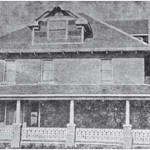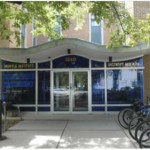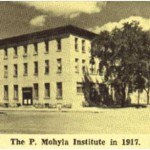St. Petro Mohyla Institute
1240 Temperance Street
The Institute is named after Metropolitan Petro Mohyla, a 17th century bishop, educator and dignitary of the Orthodox Church in Kyiv. The motto of the institute is “To be a good Canadian Citizen, it was desirable to maintain one’s origin and natural culture.” The institute opened in 1916, a time when the voice of Ukrainian individuals was starting to be heard. The Ukrainian Voice was a newspaper originally published in Winnipeg in 1910 and resembled a breakthrough for Ukrainian Canadians.
The idea for the institute originally came from a student’s group. The meetings that
established the institute were published in the Ukrainian Voice.
The idea behind establishing Ukrainian institutes in Canada was fuelled by the debate of the bilingual system. At this time, Manitoba passed a law forbidding bilingualism. However, individuals who defended bilingualism stated that schools which allowed Saskatchewan-Ukrainian individuals had advanced over schools with solely English speaking students. This assertion prompted Ukrainian individuals to donate more to Ukrainian institutes, including the St. Petro Mohyla Institute. The institute was part of the bursa movement, a process that increased the residential and cultural centers for Ukrainian Catholic men wishing to further their education.
The institute opened on September 30, 1916 and was originally located in a big house at 716 Lansdowne Avenue. The site was convenient due to its proximity to the university, high schools, and elementary schools. The institute housed 35 students, four of whom were girls. The students who lived at the institute attended Normal School, elementary school, high school, and university. In 1917, the number of students increased to 70. In 1918, the institute moved to 401 Main Street, which had formerly been the Empress Hotel. The institute remained in this location until 1964. The institute then moved to 1240 Temperance Street and opened in this location on August 14, 1965.
Many students have benefitted from the extra-curricular educational opportunities that the Institute provides. Classes were given in Ukrainian history, Ukrainian language, Ukrainian literature, dramatic arts, as well as Ukrainian choral singing and dancing. Every student was involved in a student society, known as “Kameniari”. In 1923, the women of the institute organized their own society called “Mohylianky”, which became the Ukrainian Women’s Association of Canada. The first branch of the Ukrainian Women’s Association of Canada was established in Saskatoon in 1926. Along with the Ukrainian Women’s Association of Canada, the institute has been credited with creating other organizations such as the Ukrainian Greek Orthodox Church, the Canadian Ukrainian Youth Association, and the Ukrainian Self-Reliance League of Canada.
On September 24, 2011, St. Petro Mohyla Institute was recognized as a National Historic Event by the Government of Canada Historic Sites and Monuments Board. On the same day, a celebration was held for the institute’s 95th Anniversary.
Today, St. Petro Mohyla Institute continues to fulfill the role as a contemporary residence accommodating post-secondary students.
If you would like to know more about St. Petro Mohyla Institute, please call 1-306-653-1944 or visit their website at http://www.mohyla.ca/.
This information was gathered from the following sources:
– Kindrachuk, M.J. (1978). The Petro Mohyla Institute 1916-1976 Saskatoon, Saskatchewan (Doctoral Dissertation). The Ukrainian Free University, Munich: Germany.
– Mohyla Institute gets Federal Nod at 95, Saskatoon Sun, September 18, 2011.
– Kachkowski, A. (2011). Government Honours St. Petro Mohyla Institute.
Sheptytsky Institute
1236 College Drive
Andrey Sheptytsky
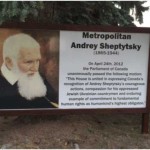
The institute is named after Andrey Sheptytsky. He was born Roman Alexander Maria Sheptytsky on July 29, 1865 in Halychyna, Western Ukraine. He studied law at universities in Krakow and Lviv from 1883-1887. Before entering into post-secondary education, Roman volunteered for the Austrian army. In 1888, he received a Doctorate in Law. Later that same year, he entered into the Basilian monastery near Lviv and adopted the name Andrey. He was ordained to the priesthood and took his monastic vows in 1892. In 1894, he received a Doctorate in Theology in Krakow and was ordained a Bishop in 1898. Bishop Andrey was nominated and installed at St. George’s Cathedral in Lviv as a Ukrainian Catholic Archbishop in 1900. He established the Ukrainian Metropolitan Museum in Lviv in 1905. In 1910, he visited North America and toured many Ukrainian communities in Canada, including Yorkton.
During World War I, Sheptytsky was arrested and imprisoned in many areas in the Ukraine and Russia. In 1927, Bishop Andrey established the first meeting of all Ukrainian Greek Catholic Bishops from North America, Czechoslovakia, and Poland. During World War II, Sheptytsky spoke out against the German Nazis who occupied Western Ukraine. He helped Jews avoid prosecution through hiding them in Ukrainian monasteries. Bishop Andrey died on November 1,1944 after having served the Ukrainian Greek Catholic Church for 56 years.
History of the Institute
The institute has its origins with the formation of the Ukrainian Catholic Brotherhood in 1932.
In 1934, the Brotherhood formed a bursa (a cultural and spiritual center), for young Ukrainian Catholic males who came from rural Saskatchewan to further their education. The original building was called the Markian Shashkevych Bursa and was established in 1935. However, due to increasing demands, the building was replaced with a larger residence. Construction began on the Metropolitan Sheptytsky Institute in 1950. The building spanned six lots on College Drive and was purchased for $1,650. The Institute opened on August 16, 1953 and the original bursa closed on October 6, 1953. From 1955 until 1966, the institute housed the Musee Ukraina Museum. The Museum then moved to the former St. George’s Cathedral Parish Hall at 204 Avenue M South.
In 1975, the Metropolitan Sheptytsky Society was formed and incorporated. Aside from students living at the institute, many teachers attended lectures on Ukrainian history, culture, and traditions at the institute. Although the institute was originally male-only, it became a co-ed residence in 1980. The Ukrainian Catholic Religious Education Centre was added in the same year. The Ukrainian Catholic Religious Education Centre consists of an extensive library that also distributes Catechism materials. The centre is operated by the Sisters Servants of Mary Immaculate. The centre was originally housed in the Sister Servants of Mary Immaculate house in Regina from 1974 until 1980 and then in Saskatoon from 1980 until 1986. In 1986, the centre moved to the Sheptytsky library, where it still operates today.
From 1998 until 2003, the institute and St. Thomas More College entered into a management agreement. After 2003, management of the institute became the responsibility of the Metropolitan Sheptytsky Society. The institute is now owned by the Saskatchewan Ukrainian Episcopal Corporation of Saskatchewan. Guests can come to the institute and speak on topics such as mental health, Ukrainian history and culture, and stress relief.
On April 24, 2012, Andrey Sheptytsky was honoured by the Parliament of Canada and was recognized as being an example of “commitment to fundamental human rights as human kind’s highest obligation”.
If you would like to learn more about the Sheptytsky Institute, please visit the following link: http://www.skeparchy.com/introduction.html
This information was gathered from the following sources:
– Gulka, W. (n.d.). Sheptytsky Institute. In The Encyclopedia of Saskatchewan. Retrieved from
http://esask.uregina.ca/entry/sheptytsky_institute.html
– Sheptytsky Institute (n.d.). Metropolitan Sheptytsky. Retrieved from
http://www.skeparchy.com/introduction_metropolitan_sheptytsky.html
– Sheptytsky Institute (n.d.). Religious Education Centre. Retrieved from
http://www.skeparchy.com/religious_education_centre.html
– Ukrainian Catholic Education Foundation (2012). Canadian Parliament Unanimously Honours
Metropolitan Sheptytsky. Retrieved from http://ucef.org/news/2171/
Lutheran Campus Ministry
1302 College Drive
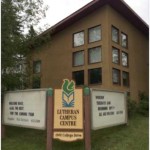
The Lutheran Student Centre was located at 314 Cumberland Avenue North from 1961 until 1975. In 1976, the Centre moved to 1302 College Drive and became known as the Lutheran Campus Ministry. The establishment of the Lutheran Campus Ministry was part of a nation wide initiative to create closer ties between academic and faith studies. The predecessor to the Lutheran Student Movement in Canada (LSMC), the Lutheran Student Association (LSAA), began meeting in the 1940s to establish campus ministries across Canada.
On November 14, 1999, a new building was erected to replace the old Lutheran Campus
Ministry building. The two-storey building consists of a chapel, lounge, meeting space, and offices on the main floor and five residences on the second floor. The Lutheran Campus Ministry offers weekly opportunities for worship, study, fellowship, and counseling.
If you would like to know more about the Lutheran Campus Ministry, please call 1-306-653-2509 or visit their website at http://www.lutherancampusministry.sk.ca/Home.html.
This information was gathered from the following sources:
– Henderson’s Saskatoon Directory, 1961-1976.
– Kuhn, K. (1979). The Lutheran Student Movement in Canada- A Brief History and Analysis. In Consensus 5, 15-21.
– University of Saskatchewan (n.d.). Lutheran Theological Seminary. In Campus Buildings. Retrieved from http://scaa.usask.ca/gallery/uofs_buildings/
